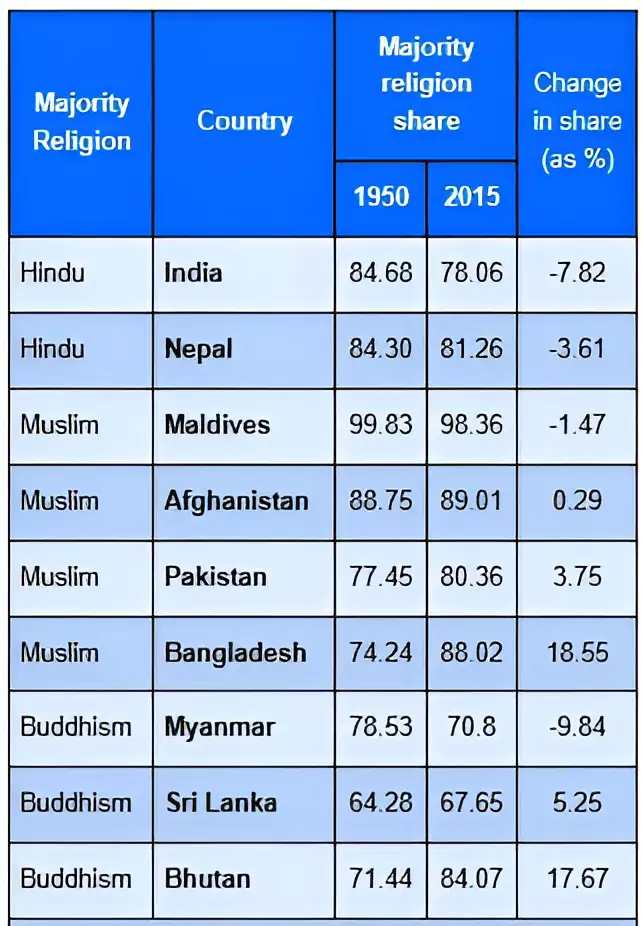Context
Recently, The Economic Advisory Council to the Prime Minister (EAC-PM) published a study that analyzed the shifts in religious demographics in India, Hindu population share dipped 7.82%, while that of Christians, Muslims, Sikhs has seen a rise in the 65-year period between 1950 and 2015.
Key highlights of the report ‘Share of Religious Minorities: A Cross Country Analysis
The Study focused on only those countries (around 167) that had a majority religion (more than 50 percent share of the total population) for 1950.
- The Share of Religious Minorities report analysis relied on the Religious Characteristics of States Dataset 2017 to track religious composition across countries.
Enroll now for UPSC Online Course
Economic Advisory Council (EAC-PM):
- PM-EAC is just like PC and NITI, this is also neither constitutional nor statutory body.
- It is an independent body constituted to give advice on economic and related issues to the Government of India, specifically to the Prime Minister.
- Started in the 2000s to give advice on economic issues to the Prime Minister within the context of Economic Planning.
- In 2017-Sep it was reconstituted this Economic Advisory Council
- Composition: Economist Bibek Debroy (as Chairman) & other notable full time and part time members, Total 7 persons.
- Terms of reference of the EAC:
- To analyze any issue, economic or otherwise, referred to it by the Prime Minister and advising him thereon;
- To address issues of macroeconomic importance and presenting views thereon to the Prime Minister. This could be either suo-motu or on reference from the Prime Minister or anyone else;
- To attend to any other task as may be desired by the Prime Minister from time to time.
- NITI aayog provides administrative and secretarial support to PM- EAC
|
Global Finding: Between 1950 and 2015,

- Indication of Greater religious heterogeneity: The global average for the share of the majority religious denomination in 1950 was 75%.
- By 2015, this figure had decreased by approximately 22%.
- Countries like India and several OECD nations have also seen declines in their majority religious shares.
- Decline of Roman Catholics in OECD Countries: Data from Of 35 OECD countries studied, 25 were from Europe, and the share of majority religious denominations( Roman Catholics) has decreased by 29 per cent in these countries.
- In contrast, many Muslim-majority countries have seen an increase in the share of their dominant religious groups.
 Changes in Africa: In 1950, animism or native religion was the dominant faith in 24 African countries.
Changes in Africa: In 1950, animism or native religion was the dominant faith in 24 African countries. -
- However, by 2015, none of these 24 countries retained a majority adherent to these indigenous religions.
- Changes in South Asia: In the South Asian region, there’s a contrasting trend where the majority religious group is increasing in dominance.
- However, minority populations have experienced significant declines in countries like Bangladesh, Pakistan, Sri Lanka, Bhutan, and Afghanistan.
Finding About India, Between 1950 and 2015,
-
- Hindu Population: the Hindu population in India decreased by 7.82%.
- Muslim Population: the Muslim population in India increased by 43.15%, indicating an environment conducive to religious diversity.
- Christian Population : The Christian population in India saw a modest rise from 2.24% to 2.36%, reflecting a 5.38% increase.
- Sikh Population: the Sikh community experienced a rise in its share, increasing from 1.24% to 1.85% , reflecting a 6.58% increase.
- Parsi Population : Contrary to the overall trend, the Parsi population in India witnessed a significant decline of 85%, decreasing from 0.03% in 1950 to 0.004% in 2015.
- Jain Population: The share of Jains declined from 0.45 per cent to 0.36 per cent.
- It said the total fertility rate (TFR) among all religious groups was declining and the
- The highest decrease in TFR from 2005-06 to 2019-21 was observed among Muslims, a 1 percentage point drop in their TFR.
- Hindus saw a 0.7 percentage point drop.
Implications of Report:
- The report implies that demographic shifts in India signal a favorable environment for diversity.
- India’s inclusive policies have fostered diversity, evident in the growing number of minority populations without pinpointing specific causes.
- It underscores the significance of defining and safeguarding minority rights, citing India’s relative success compared to neighboring countries.
Enroll now for UPSC Online Classes
![]() 14 May 2024
14 May 2024

 Changes in Africa: In 1950, animism or native religion was the dominant faith in 24 African countries.
Changes in Africa: In 1950, animism or native religion was the dominant faith in 24 African countries. 